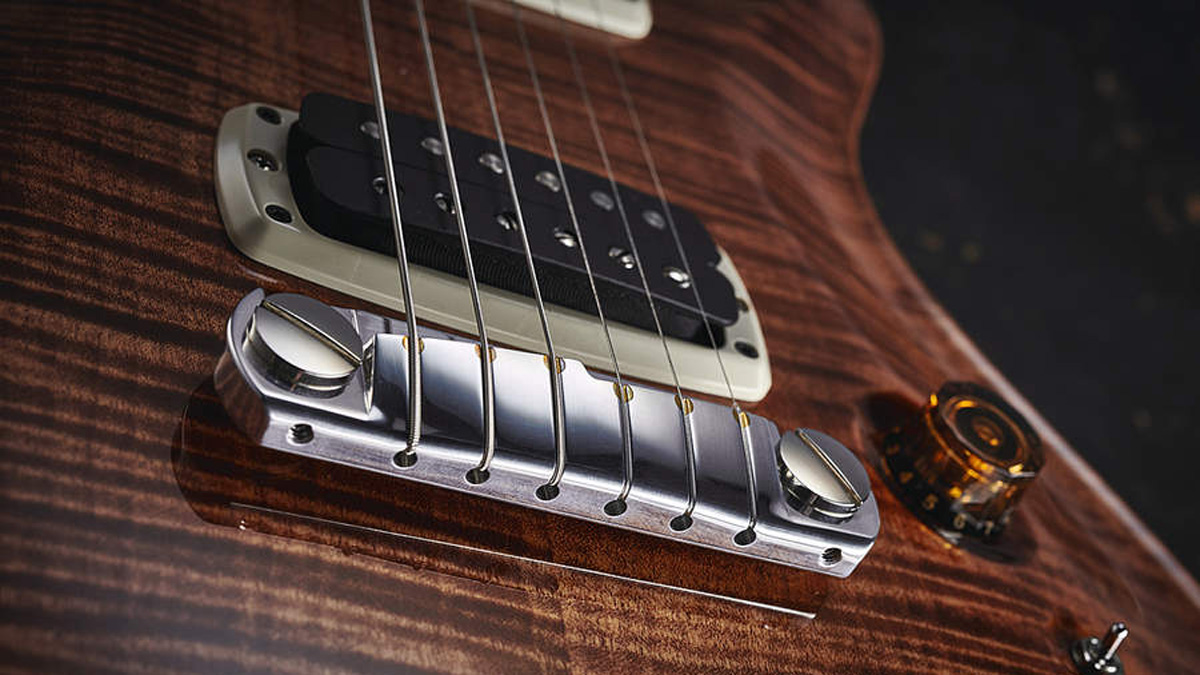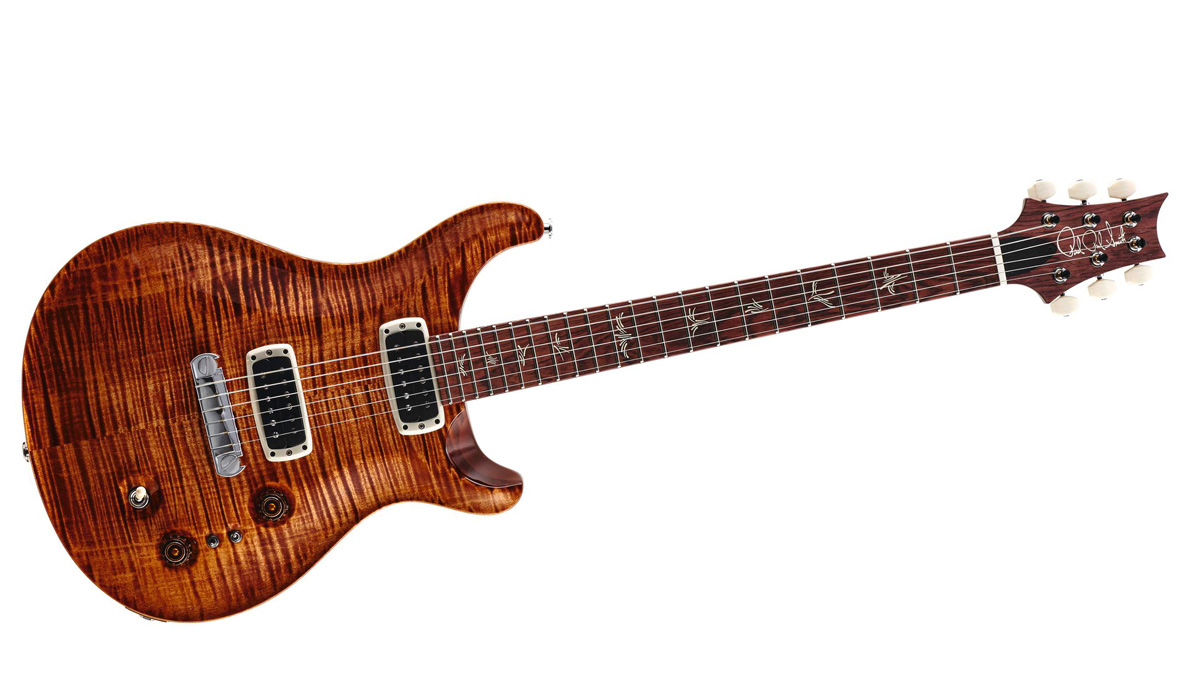MusicRadar Verdict
The sort of instrument that makes you reevaluate your collection.
Pros
- +
Typically high-quality detailed build.
- +
Top-drawer versatile sounds.
- +
Great neck and feel.
- +
Light in weight.
- +
Nitro finish.
Cons
- -
No vibrato or left-hand option.
MusicRadar's got your back
Constant evolution wouldn’t be a bad motto for a guitar company who’ll be celebrating its 35th Anniversary in 2020.
PRS has relatively few body shapes, but the classic double-cut outline comes in many flavours and is constantly tweaked and upgraded in the ongoing pursuit of creating a better instrument.
In recent years, that focus has fallen on the more Gibson Les Paul-inspired 594 with its shorter scale length, a classic four-control layout and two-piece bridge.
And then there was the Silver Sky, a closely Stratocaster-inspired guitar designed to suit the demands of John Mayer.
It could be argued, then, that Paul Reed Smith’s original vision - a hybrid of both those benchmark designs - has taken a back seat. Well, what better way to put it back on the map than with not one but two versions of the guitar the company founder wants to play?
Now, with a price that starts at £3,699/$3850, the core USA Paul’s Guitar won’t be in everyone’s budget. PRS guitars never were. But launched at the same time is the Asian-made SE version at a ‘champion-of-the-people’ price of just £799/$999.
In simple terms, the guitars appear pretty similar, centred on the original PRS scale of 635mm (25 inches) with a 22-fret rosewood fingerboard, a mahogany neck and body back topped off with a centre-joined slab of figured maple - even the pickups and electrics appear the same in terms of function. Both also employ the one-piece Stoptail wrapover bridge, quite a rarity in the contemporary PRS line-up. Here, we’re looking at the Core model.
Build
Leaping up in price from the SE by pretty much £3k, the USA model is on a completely different level - and then some. At this price, you should expect nothing short of perfection, and if quality and detail are your thing, we can’t think of many who would be disappointed here.
Based on the thicker-bodied 22-fret McCarty design, it’s another beautifully lightweight instrument. The thin, fully nitro copper finish lightly tones the African mahogany one-piece back and South American mahogany neck and makes the centre-jointed figured maple top look almost like a flamed mahogany rather than the often showier colours in PRS’s paint box.
Here, we get the fully contoured top carve - like a more enhanced, sharply contoured version of an old violin - with indents for the controls, three-way toggle switch and even the pair of mini-switches. This more classic appearance ties in very well with the Honduras rosewood fingerboard and headstock facing, milk chocolate in colour with dark chocolate figure.
The tasteful brushstroke bird inlays are downsized, and while that inlaid signature logo (both are from an imitation ivory) is certainly sizeable, it also ties in with the finely fettled bone nut and grained ‘faux bone’ tuner buttons. The considered appearance continues with amber lampshade knobs and those unique ivory-coloured plastic pickup rings.
The bridge looks to be plated - the tops of the brass studs certainly are - but, as ever, there’s no plating on the brass-coloured string posts of the Phase III locking tuners that fit, vintage-style, via grommets onto the headstock. The tuners are open-backed and the black top locks tie in with the plain black anodised aluminium truss rod cover.

The neck adopts the Pattern profile, which, we’re told, is “an updated Wide Fat PRS neck based on Paul’s pre-factory designs found on the instruments built for Carlos Santana, Peter Frampton and Howard Leese from the late 70s to the mid-80s”. Typically, we have quite a large heel that extends full width into the body and under the neck pickup. The fret gauge is very slightly wider than the SE and slightly taller, too, and there’s no attempt to hide the fret tangs, which are visible on the rounded fingerboard edges. It’s great guitar making, and if there is a hair out of place, we couldn’t find it.
The main differences from the previous Paul’s Guitar are the pickups and electronics. As before, the TCI pickups here follow the 408’s neck pickup, some 5mm narrower than a standard humbucker. We discuss these new TCI humbuckers elsewhere with Paul Reed Smith (see p94), but suffice to say they represent the latest in a long line of humbucking/single-coil voices that Paul has constantly worked to update and improve.
Sounds
The SE’s Wide Fat neck shape is very slightly fatter than others we play or have measured, and marks a good start to our play test, although we did up the string gauge to 10s. It certainly makes for a slightly less crisp acoustic voice, and clarity is very much a part of what we’re presented with here. Setup is slick, intonation is exemplary, and there’s a good ring and resonance.
Whether it’s that neck feel, or maybe those abalone bird inlays, or the lack of a headstock overlay, there’s something here that’s taking us back in time to the original style of PRS - that early 90s period of change heralded by the first Dragon guitar with its 22 frets and Stoptail bridge, and the subsequent Custom 22 production model.
The current core models don’t stand still. So many brands struggle to capture the magic of their early classics, but PRS has never had to bother: constant improvements and new ideas mean that its guitars continue to improve and evolve. Paul’s Guitar is no different. Even unplugged, it rings like a bell and feels (while obviously similar to the SE) just better: more substantial, fuller-sounding. Common to both is a clarity and quick response. The Pattern neck might be based on the original Wide Fat, and yet not only in comparison to the SE version here but also our battle-scarred 1994 Custom 22, it actually feels a little narrower side to side, even though the dimensions are virtually identical. It’s not a big late-50s neck that’s for sure, but it sits in that classic era. Importantly, we’re not thinking it’s a ‘big’ or ‘skinny’ neck: we’re just playing it.
As we plug in the SE, that old-style PRS feeling continues. There’s quite a contrast between the humbucking and single-coil voices, the latter having a crisp high-end, especially in the neck position compared with our reference Strats.
Then we realise that the neck pickup is placed conventionally with the screw coils facing the neck, unlike the USA version. Reversing it takes minutes and while the world didn’t change, it does add a couple of per cent: for a very un-Strat-like build, we’re hearing a pretty good, clean and present single coil with plenty of woody chop.
The neck humbucker sounds a little thick in comparison, but screwing down the lower four polepieces, like the USA model, subtly cleans things up. It doesn’t sound like it needs that at the bridge, though; it’s a pretty good, quite balanced hot-vintage voice. And while the slug coil is a little brightly voiced, knocking back the tone certainly sweetens it. As ever, the key to maximising the duality of sounds is via the volume and tone.
Plugging in the core version is a bit like getting out of a Fiat Panda and climbing aboard a Ferrari. It sounds bigger than the SE and then some. The humbucker-to-single-coil volumes are more matched in output but not as matched as the first version of Paul’s Guitar, for example, or the 24-08, which used a tapped-coil concept.
Here, though, the single coils sound stellar, especially the all-important neck pickup that... Well, this writer wishes he had that sound on his gigging Strat – that really woody, marimba-like chop that’s hugely percussive whether you’re bending and wailing your Texas blues or funking it out chez Nile. Switch down to the bridge humbucker and Paul rightly references the P-90 as it presents a quite vicious snarl; switch to single coil and you’ll pull out your inner Roy Buchanan. Then again, pull the volume back, switch to a clean amp with some slapback and you’re in a rootsy early rock ’n’ roll world.
The volume control here is king. The neck pickup? It’s Paul’s famously ‘whoopy’ sound into anything approaching a clean-to-crunchy amp voice - a violin-like voice. Pull back the volume control, though, and you could sit in seamlessly with Snarky Puppy’s grooves.
The single-coil mix, of course, is pre-set, but it has surprising bolt-on-like bounce and having one pickup in humbucking mode and the other in single-coil goes some way to getting those graduated mixed sounds of a Les Paul, especially if you roll the volume back a little. There’s a lot about the character of this guitar’s humbucking sounds that remind us of a good Les Paul Deluxe or a P-90-loaded Les Paul. But it’s the single-coil voices that seal the deal. We can’t remember hearing better from a humbucking PRS.
This guitar reminds us just how valid the original ‘hybrid’ PRS recipe remains for the journeyman player who needs to cover a lot of sonic ground with one instrument. It’s not a Les Paul; it’s not a Stratocaster. Yet while it certainly references both of those camps, it somehow ends up being very much its own thing.
Aside from the effortless playability, intonation, tuning stability and old-world resonance (all foundations of the PRS empire), the single-coil voices from these new TCI pickups raise the bar, while the humbucking side seems to pack musical heat, clarity and considerable versatility in equal measure.
It’s the sort of instrument that makes you reevaluate your collection. Of what is a hugely vintage-informed design, the icing on the cake is its musical voicing. That didn’t happen by accident. “I’m gonna be like one of those great old violin makers,” reflects Paul Reed Smith, “You know, the ones who made their best stuff when they were old. Isn’t that interesting? I don’t want it to be that way, but that’s the way it is.”
Dave Burrluck is one of the world’s most experienced guitar journalists, who started writing back in the '80s for International Musician and Recording World, co-founded The Guitar Magazine and has been the Gear Reviews Editor of Guitarist magazine for the past two decades. Along the way, Dave has been the sole author of The PRS Guitar Book and The Player's Guide to Guitar Maintenance as well as contributing to numerous other books on the electric guitar. Dave is an active gigging and recording musician and still finds time to make, repair and mod guitars, not least for Guitarist’s The Mod Squad.
With its latest free update, Ableton has finally turned Note into the app I always wanted it to be
Technically capable, but struggle to make your tunes sound musical? 5 simple music theory hacks to make your tracks stand out
"Despite its size, it delivers impressive audio quality and premium functions as well as featuring a good selection of inspired sounds": Roland GO:Piano 88PX review











